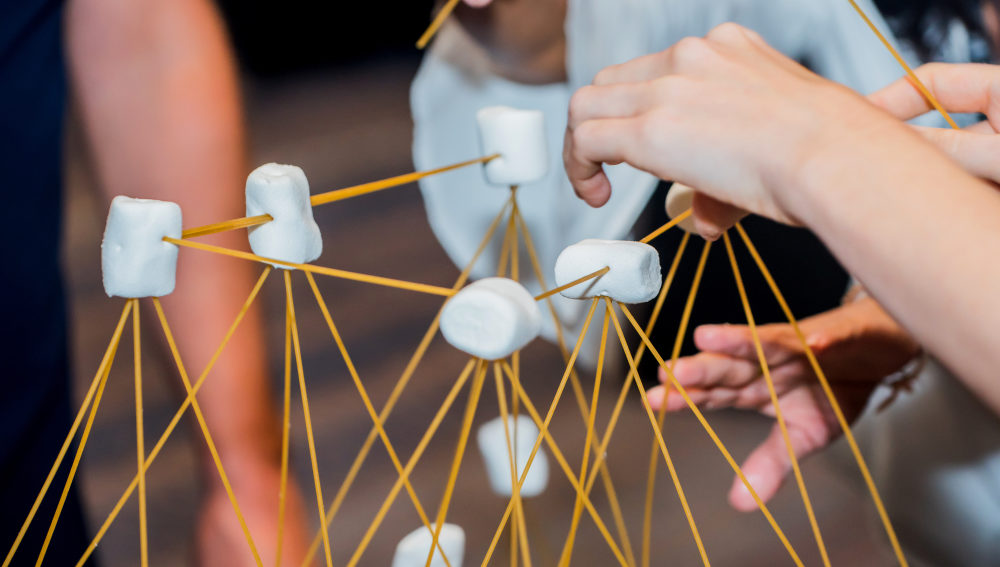As the saying goes, there’s no I in team. And while this is true, it doesn’t mean we shouldn’t identify and leverage unique individual strengths. Doing so allows us to create the foundation of our teams and lead them to success.
To help analyze the abilities of your employees, you might consider CliftonStrengths activities. Created by educational psychologist Donald Clifton, these types of activities help individuals identify and build upon their strengths.
By participating in a series of these exercises, you can help your team work together more effectively and ultimately increase workplace engagement.
1. The Marshmallow Challenge
The goal of the marshmallow challenge is to build the tallest freestanding structure using spaghetti, string, tape, and one marshmallow, which must be placed at the top of the structure.
By splitting your team into smaller groups and allowing them to create something in a short period of time, you’ll learn much about the nature of their collaborative methods.
How It Works
Each group will receive a paper bag containing 20 pieces of uncooked spaghetti, 1 yard of string, 1 yard of tape, and one marshmallow. They will have 15 minutes to use these items (bag included) to create the tallest structure possible. Once the timer runs out, you’ll measure the towers, declare a winner, and gather for a discussion.
What to Look For
During the debriefing from this activity, you’ll want to ask the participants:
- What did you notice during the activity?
- Who in your group stood out?
- Who took charge, and how did they do so?
- What strengths did you notice at work?
Through this discussion, you’ll gain a deeper understanding of how individuals perform in leadership roles. You’ll also learn who quickly steps into said roles, who stands back, and how well they perform in either capacity.
2. The Strengths Manifesto
A reflective activity, the Strengths Manifesto allows team members to respond to a series of prompts. While not as game-oriented as the other activities, it provides participants a chance to give and receive advice on how to handle interpersonal dynamics.
How It Works
The Strengths Manifesto requires little in terms of materials. All you need is a pre-made handout that contains the following prompts:
- You get the best of me when…
- You get the worst of me when…
- You can count on me to…
- What I need from you is…
In a group setting, provide this handout to each team member, and give them ten minutes to complete the four prompts. Each team member can then share their responses with the room.
What to Look For
As you listen to each team member––and provide responses of your own––take note of any common threads like, You get the best of me when you respect me, you’ll also find more idiosyncratic ones like, You get the worst of me when you don’t say please and thank you.
The Strengths Manifesto gives you the opportunity to hear how each team member wants to be treated and what they view as their contributive capacities. Once all the responses have been read, you should record them in a document accessible to the entire team, allowing individuals to refresh themselves when necessary.
3. The Paper Tower
Similar to The Marshmallow Challenge, The Paper Tower involves dividing your team into smaller groups and having them build a freestanding structure. What separates this activity––apart from the materials––is the allotment of time.
How It Works
Start by dividing your team into smaller groups of 3-6 people. From there, you’ll give each group a roll of tape and an arbitrary number of pieces of paper (20-40 pieces should suffice).
From there, you’ll provide each group with 5 minutes to design their structure––during which time they may not touch the tape or paper––and 10 minutes to construct it. Once the time has run out, you’ll measure each structure and declare a winner.
What to Look For
As you debrief from this activity, consider asking your team the following questions:
- What differences did you notice in the design and construction phases?
- Who in your group stood out?
- What obstacles did you run into, and how did you resolve them?
- What strengths did you notice in your groupmates?
The Paper Tower will provide you insight into leadership and teamwork styles. However, with the addition of the design phase, you’ll also learn about how people organize themselves, how they divvy up tasks, and how they respond to complications within their plans.
4. Nuclear Disposal
Nuclear Disposal requires a bit more preparation than other activities, but it provides a tactile manner with which to examine the adaptability of your team members.
How It Works
To administer this activity, you’ll need:
- 2 small traffic cones
- 2 4-inch PVC couplers
- 1 tennis ball
- 1 softball
- 1 small playground ball
- 100 feet of ¼-inch nylon rope cut into 8 sections of 10-12 inches in length
To set it up:
- Drill 8 ¼-inch holes on the outside of the PVC coupler
- Thread a piece of rope through each one
- Tie a knot on the outside so that it creates a handle of about 10 inches.
- Repeat this process for all 8 holes
Start by placing the first traffic cone on one edge of the room and the second cone on the opposite end. Place the coupler on top of the traffic cone with its ropes spread out. Then rest the smallest ball on top of the coupler, balancing the whole thing on top of the cone.
Divide your team into groups of 4-8 people. To perform this task, each group member must take one of the coupler ropes. Touching only the ropes, each group must pick up the ball and take it safely to the top of the other cone. If the orb falls off, then you start over.
Once you’ve completed this with the smallest ball, repeat the process with the larger ones, which will be more difficult.
What to Look For
To debrief from this activity, you’ll want to ask each participant:
- How did the actions of your group members affect your performance (both negatively and positively)?
- What strengths did you see at work in your group?
- How do your strengths enable you to adapt to changes?
Balancing objects between eight people is no simple task, and the slightest movements from one group member can cause seismic shifts in the group’s balancing efforts. Because of this shifting terrain, the Nuclear Disposal game allows you to observe how team members adapt to changes on the fly and work together when challenged.
Strengthen Your Team
Even if your business has a strong team of talented individuals, not all strengths are identical, and they may not interact naturally in synergistic ways. That’s why it’s important to understand the unique strengths of each team member and how they work among and with others. This will allow you to more successfully hit outcomes by leveraging your team’s natural strengths.
Team Development with PeopleAK
PeopleAK has over 40 years of experience in executive recruitment and business consulting.
With an individualized approach to suit your unique team, we implement strategies to achieve your goals and create solutions that spur team member engagement.
We aim to empower businesses with the right tools and people to help them scale. No guessing games. No fluff.

